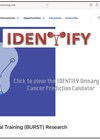Unscheduled haematuria admissions ranks among the most common urological emergencies, yet its investigation and management still lack standardisation. The readmission rate for haematuria is substantial, with reports as high as 8%, and the median hospital stay for such cases in the UK is 10 days [1].
Evidence suggests that haematuria primarily impacts a high-risk, vulnerable population, often comprising older individuals with a high burden of comorbid conditions [2]. This implies that the management of the underlying condition can be complicated by the simultaneous presence of comorbidities and its consequent use of anticoagulant and antiplatelet therapies. The presence of visible haematuria is considered a significant diagnostic indicator of urological malignancies, such as bladder cancer, with 66% of patients presenting with this symptom as their initial manifestation [3]. These factors may collectively contribute to the higher mortality rate in this cohort compared to other typical urological cases, with mortality rates of 5% within 30 days and 23% within one year reported in a UK-based single centre audit [2,4]. Hence, these indicators point to the need for improvements in the management of these patients.
Additionally, the resource requirements for unscheduled haematuria admissions can be demanding, as they often necessitate the need for specialised supervision and continuous nursing care for procedures including washouts and irrigation. For further illustration, the cost of radiation cystitis has been estimated at approximately €23,706 per patient within the Irish public healthcare system [5]. Delays in procedural interventions may also occur due to concerns regarding anaesthetic risks or extended periods of conservative management. Adopting standardised management protocols for unscheduled haematuria admissions may facilitate more timely definitive interventions, leading to reduced hospital stay durations and lower healthcare expenditures. This is corroborated by the 2018 Get It Right First Time (GIRFT) national urology specialty report, which identified the reduction of length of stay for urology patients as a key priority, given its substantial knock-on impact on patient experience and the overall efficiency of patient flow within the department [1]. According to a Eurostat report, the average hospital stay for patients with genitourinary conditions in the UK was 6.2 days in 2018. In a project designed by Newton in collaboration with three areas in the North of England and Better Care Fund programme, it was noted that 36% of hospital patient delays are attributed to a lack of accountability for patient care, inadequate monitoring of patient progress, and insufficient communication regarding the expected outcomes of the patient’s condition [6]. This highlights the necessity of establishing a standardised protocol for managing patients admitted with haematuria.
However, there is still insufficient evidence to direct clinical practice and inform guideline recommendations. Our systematic review (PROSPERO CRD42023466710) of 3162 abstracts points towards a paucity of data, with the absence of large-scale prospective studies on the management of unscheduled inpatient haematuria. As it stands, the European Association of Urology (EAU) and other international authorities do not specify recommendations on the timing and management of unscheduled inpatient haematuria [7,8]. The Ward AdmSsion of Haematuria: an Observational mUlticentre sTudy (WASHOUT) study, led by the British Urological Researchers in Training (BURST) Collaborative, which has previously overseen large-scale international studies such as the Investigation and Detection of Urological Neoplasia in Patients Referred With Suspected Urinary Tract Cancer (IDENTIFY) and the Transurethral REsection and Single instillation intra-vesical chemotherapy Evaluation in bladder Cancer Treatment (RESECT) study [9,10], will offer urologists worldwide the opportunity to evaluate their practices and contribute to the much-needed high-quality observational data on the management and outcomes of unscheduled haematuria admissions [11]. The findings collected during the study will be applied to the formulation of evidence-based best practice guidelines.

Figure 1: Overview of WASHOUT study design.
What is the WASHOUT study?
The WASHOUT study, an international multicentre prospective observational study, was formally launched in early 2024 and continues to welcome new hospital site registrations (Figure 1). Designed to elucidate the management strategies of unscheduled admissions due to haematuria, the study will encompass all causative factors to ensure the generalisability of the findings. The study’s inclusion criteria include any patients over the age of 18 with an unscheduled admission to a participating secondary care centre for haematuria as the primary or secondary diagnosis. The exclusion criteria include patients with traumatic haematuria stemming from catheter-associated trauma, postoperative bleeding, or any urological injury, as well as those with a hospital stay shorter than 24 hours. Data obtained will establish factors associated with adverse outcomes and / or increased resource use at a population level. Data will also help describe the degree of variation that exists nationally and internationally in the management of unscheduled haematuria, and associate this with clinical outcomes. Using observational data to emulate a target trial [12], the study’s primary outcome is length of stay, with secondary outcomes involving resource use, readmission rates, and 90-day mortality rates.

Figure 2: Timeline of the WASHOUT study for UK sites.
Recruitment
WASHOUT is open to participation from all hospitals offering acute urology services, nationally and internationally. In the UK, this study is classified as a service evaluation and does not necessitate ethical approval. Figure 2 demonstrates the timeline for UK hospital sites from registration to the study completion. Collaborators who submit a minimum of 15 cases will receive PubMed-indexed collaborative authorship, which will be awarded to one collaborator and a supervising consultant. For every additional 10 prospective cases submitted, another collaborator will be eligible for inclusion in the collaborative authorship. The study steering committee will invite top recruiters to join as mainline authors.

Figure 3: Global heat-map of UK registered sites.
Where are we currently with the WASHOUT study?
Following the formal launch of site registration for WASHOUT in January 2024, we have officially included 246 centres from over 40 countries in the study. In the UK, over 125 out of the 200 hospitals with urology services are now registered so don’t miss the chance to get involved (Figure 3). Moreover, more than 1500 anonymised patient records have been added into our database using REDCap, a secure web-based application for constructing and managing online surveys and databases. The strong launch and early recruitment statistics result from a collective international effort focused on advancing care for this patient cohort. Site recruitment remains open for interested hospital sites(https://redcap.link/washoutregistration).

Figure 4: League table of participating hospital sites in the UK.
Study innovation
BURST’s collaborative research model has evolved to incorporate several innovative strategies with the goal of enhancing study participation, streamlining data entry, and ensuring high-quality data. Drawing on insights from recruitment in our previous studies, the WASHOUT leaderboard presents a league table that ranks the sites based on performance indicators such as the number of cases entered into the REDCAP database, and the number of fully followed-up cases (https://bursturology.com/project/washout) (Figure 4). Regular updates and accessibility of the league table to all collaborators are intended to showcase the dedication and achievements of high-volume sites and countries. This initiative not only acknowledges the hard work of our participating hospitals but also serves as a motivational tool to promote the highest standards of data quality and study adherence throughout the research. Top collaborators at the study’s conclusion will be invited for mainline authorship.
The WASHOUT study incorporates a real-time data quality app that identifies errors and facilitates timely corrections, ensuring that any problems with the clinical research forms are resolved in a timely manner. Moreover, akin to the previous RESECT study, WASHOUT will utilise an authorship application designed to compute the requirements for collaborative authorship and automatically generate individual certificates.
IF YOU HAVEN’T ENROLLED YET, ENROLL NOW AT
https://redcap.link/washoutregistration
References
1. Harrison S. GIRFT programme national specialty report. NHS Improvement 2018.
2. Pavithran A, Bhatt NR, Banerjee G, et al. Management of inpatient macroscopic haematuria: a typical urology emergency with a high mortality. Urology 2022;166:22–8.
3. Edwards TJ, Dickinson AJ, Natale S, et al. A prospective analysis of the diagnostic yield resulting from the attendance of 4020 patients at a protocol-driven haematuria clinic. BJU International 2006;97:301–5.
4. NHS Digital. Hospital admitted patient care activity. 2024.
https://digital.nhs.uk/data-and-information/
publications/statistical/hospital
-admitted-patient-care-activity
5. Gilmartin B, O’ Meara SO, D’arcy FTD, et al. A0083 - Cost burden of radiation cystitis presentations and investigations to a tertiary referral hospital in Ireland. European Urology 2023;83:S122.
6. NHS England. Why not home? Why not today. Monthly Delayed Transfers of Care Situation Report. 2018.
https://www.england.nhs.uk/statistics/wp-content/
uploads/sites/2/2018/11/Monthly-Delayed-Transfers
-of-Care-Situation-Report-Principles
-Definitions-and-Guidance.pdf
7. EAU Guidelines. https://uroweb.org/guidelines
8. NICE. Bladder cancer: diagnosis and management. NICE guideline [NG2] 2015
https://www.nice.org.uk/guidance/ng2
9. Khadhouri S, Gallagher KM, MacKenzie KR, et al. The IDENTIFY study: the investigation and detection of urological neoplasia in patients referred with suspected urinary tract cancer – a multicentre observational study. BJU International 2021;128:440–50.
10. Gallagher KM, Bhatt NR, Clement K, et al. Study launch: transurethral REsection and Single instillation intra-vesical chemotherapy Evaluation in bladder Cancer Treatment (RESECT). BJU International 2020;126:310–11.
11. Byrnes KG, Bhatt NR, Ippoliti S, et al. Introducing WASHOUT: A Large-scale Observational Study of Inpatient Haematuria. European Urology Focus 2024;10(2):303–5.
12. Matthews AA, Danaei G, Islam N, et al. Target trial emulation: applying principles of randomised trials to observational studies. BMJ 2022;378:e071108.
[All links last accessed October 2024]
Declaration of competing interests: BURST has received funding from The Urology Foundation, Action Bladder Cancer UK and the Charles Reynolds Foundation in support of this study.









